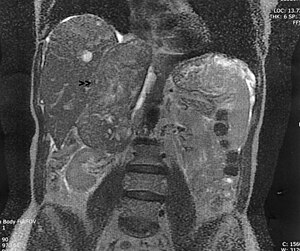Leiomyosarcoma
| Leiomyosarcoma | |
|---|---|
 |
|
| Leiomyosarcoma of the adrenal vein. Coronal view of abdominal MRI. Tumor (arrow) extends from the superior pole of the right kidney to the right atrium. | |
| Classification and external resources | |
| Specialty | Hematology and Oncology |
| ICD-10 | C49.M48 |
| ICD-O | M8890/3 |
| DiseasesDB | 34362 |
| MedlinePlus | 000916 |
| eMedicine | med/1180 |
| MeSH | D007890 |
Leiomyosarcoma (Gr. "smooth muscle connective tissue tumor"), also referred to as LMS, is a malignant (cancerous) smooth muscle tumor. A benign tumor originating from the same tissue is termed leiomyoma. It is also important to note that leiomyosarcomas do not arise from leiomyomas.
Leiomyosarcoma is a rare form of cancer, and accounts for 5–10% of soft-tissue sarcomas, which are in themselves relatively rare. Leiomyosarcomas can be very unpredictable. They can remain dormant for long periods of time and recur after years. It is a resistant cancer, meaning generally not very responsive to chemotherapy or radiation. The best outcomes occur when it can be removed surgically with wide margins early, while small and still in situ.
Smooth muscle cells make up the involuntary muscles, which are found in most parts of the body, including the uterus, stomach and intestines, the walls of all blood vessels, and the skin. It is therefore possible for leiomyosarcomas to appear at any site in the body. They are most commonly found in the uterus,stomach, small intestine and retroperitoneum.
Uterine leiomyosarcomas come from the smooth muscle in the muscle layer of the uterus. Cutaneous leiomyosarcomas derive from the pilo-erector muscles in the skin. Gastrointestinal leiomyosarcomas might come from smooth muscle in the GI tract or, alternatively, also from a blood vessel. At most other primary sites—retroperitoneal extremity (in the abdomen, behind the intestines), truncal, abdominal organs, etc.—leiomyosarcomas appear to grow from the muscle layer of a blood vessel (the tunica media). Thus a leiomyosarcoma can have a primary site of origin anywhere in the body where there is a blood vessel.
The tumors are usually hemorrhagic and soft and microscopically marked by pleomorphism, abundant (15–30 per 10 high power fields) abnormal mitotic figures, and coagulative tumor cell necrosis. There is a wide differential diagnosis, which includes spindle cell carcinoma, spindle cell melanoma, fibrosarcoma, malignant peripheral nerve sheath tumor and even biphenotypic sinonasal sarcoma.
...
Wikipedia
